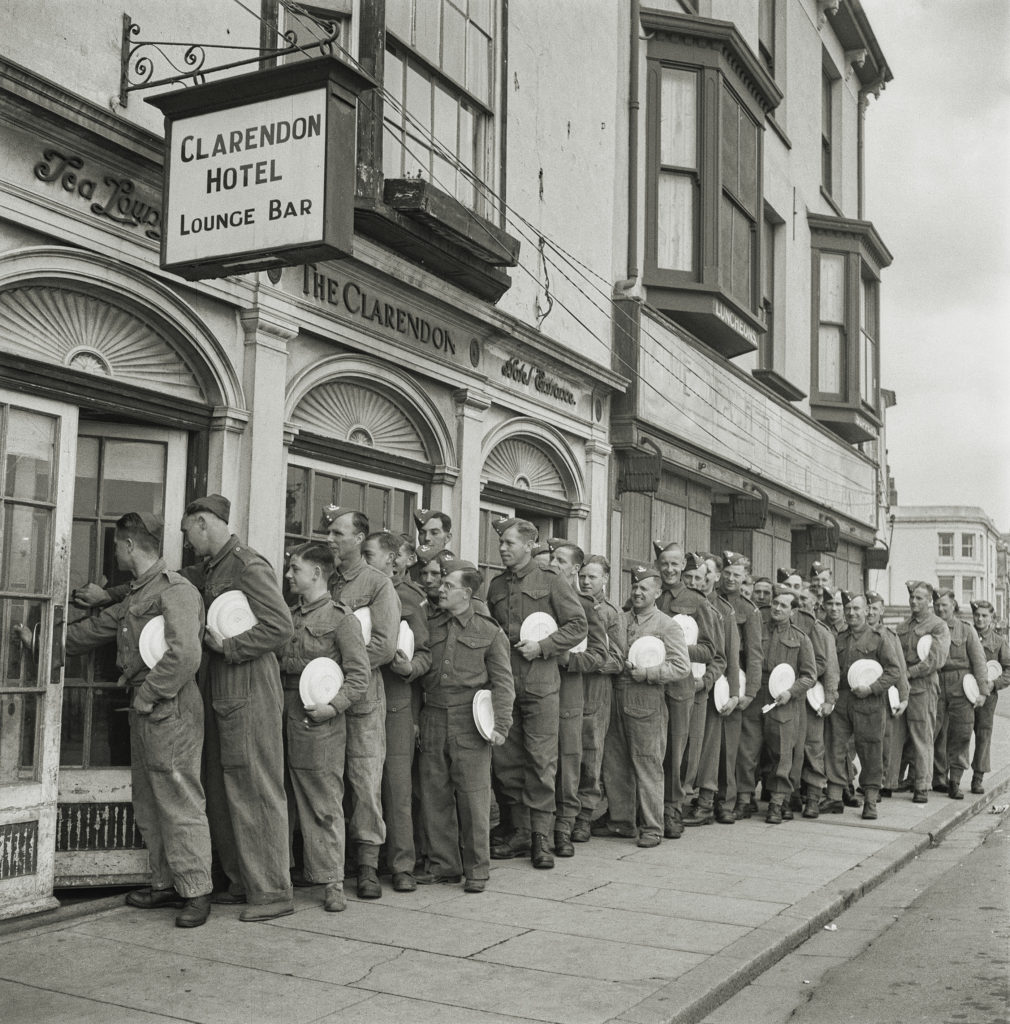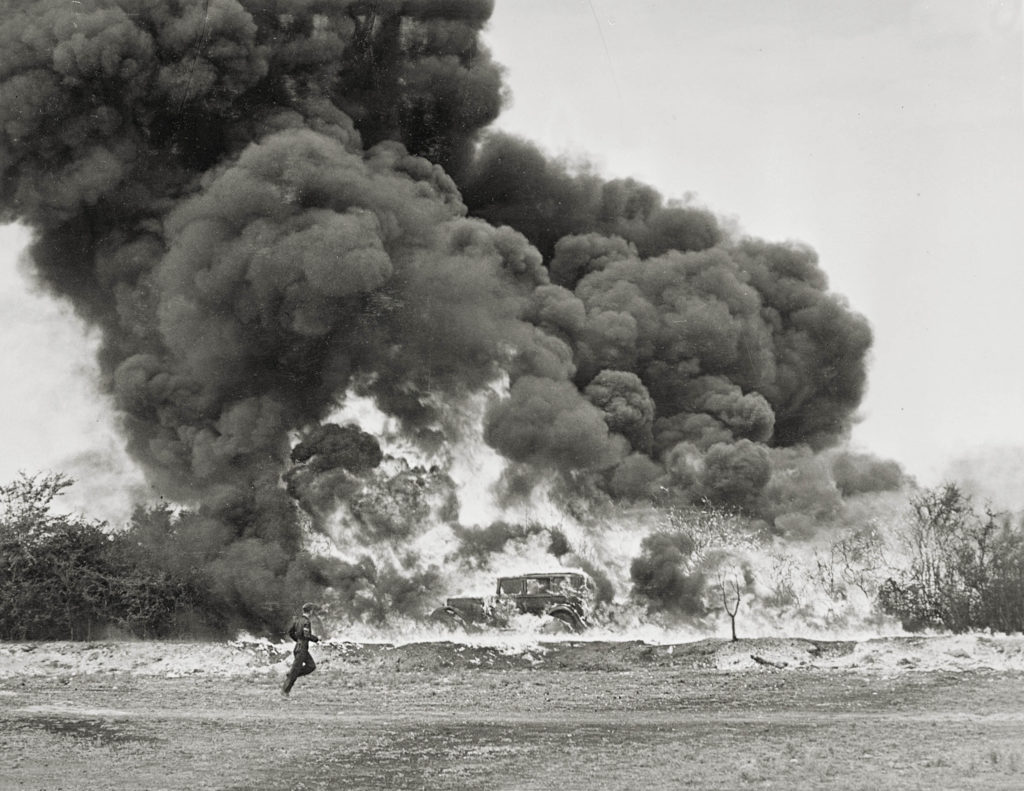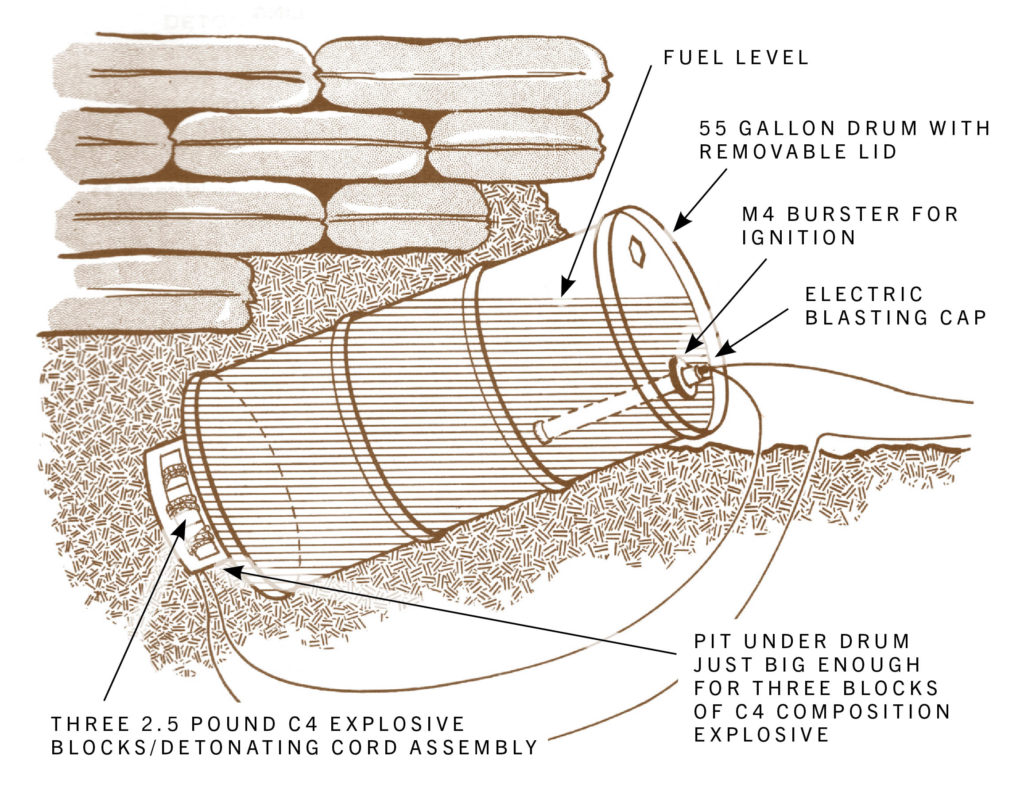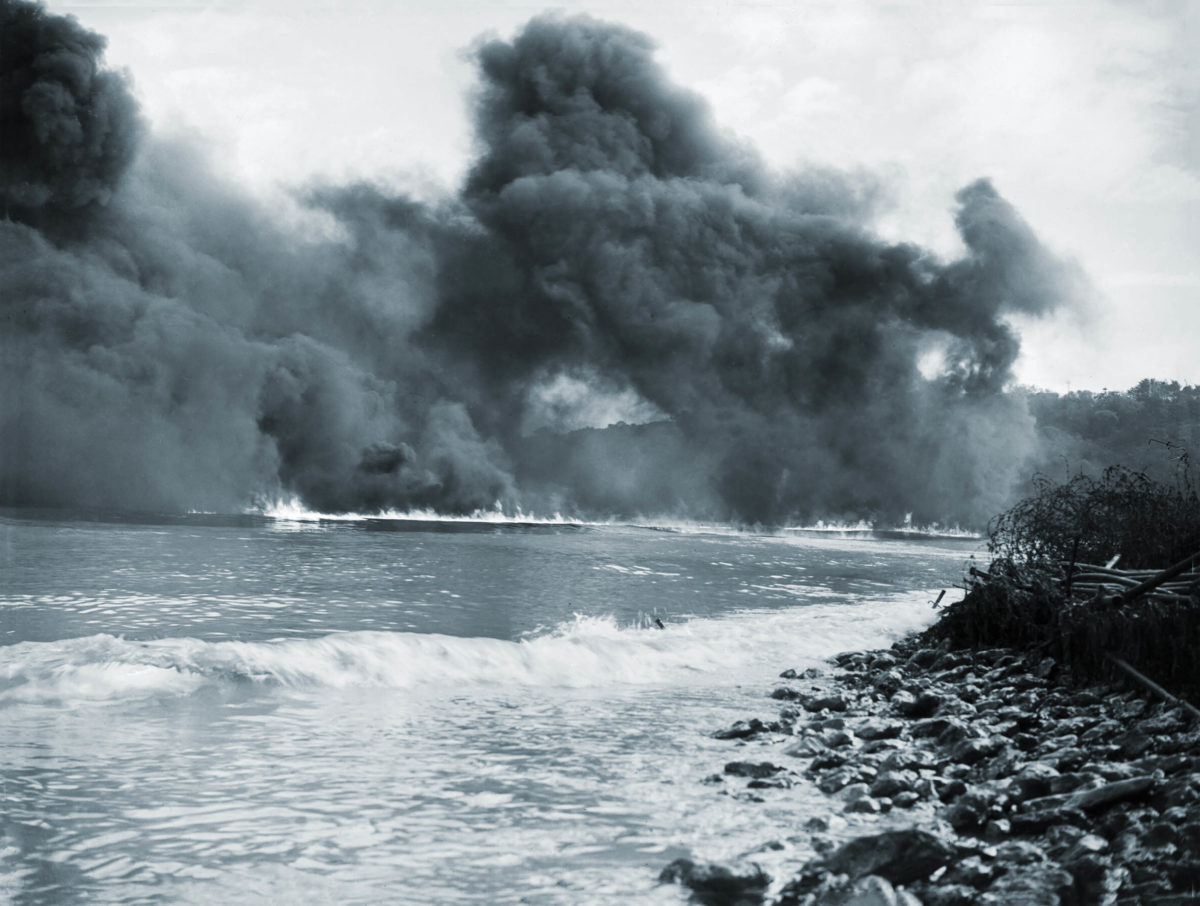Eight miles north of the White Cliffs of Dover sits Deal, a picturesque resort town renowned for its pebble beach and classic Victorian buildings. Prewar visitors used to stroll along the beachfront promenade, grabbing an ice cream cone along the way. Others jumped into the bracing sea for a swim. On a clear day, beachgoers could see the coast of France, 25 miles across the English Channel. In June 1940 the frolicking came to a screeching halt after Germany attacked and occupied France. Deal’s storefronts were boarded up. The promenade was festooned with barbed wire. Concrete bunkers popped up along the beaches. Soldiers replaced the tourists.
It had been only a couple of weeks since the Germans had pushed French and British troops into the sea at Dunkirk. During the ensuing evacuation of nearly 340,000 soldiers, the British Army left behind massive quantities of weapons, including 1,500 artillery pieces, 600 tanks, and 60,000 assorted vehicles. Due to these losses Britain found itself, in a very real sense, unable to wage war. Worse yet, the British government faced the real possibility that the enemy would invade England in the early autumn, a plan the Nazis called “Operation Sealion.” (If the Wehrmacht knew how desperately depleted Britain’s arsenal was, they might have pushed up their timetable.) The defense of the realm was at stake, and the War Office frantically sought solutions to repulse the onslaught before the Germans could reach English soil. The powers-that-be came to believe the best way to deter the Germans was a stable of flame-based defensive weapons.
Britain’s use of fire in battle dates back centuries. The Royal Navy, for example, had utilized fire as a weapon in 1809 when they sailed flaming ships directly at Napoleon’s fleet, panicking the French and sending them scurrying away in such haste that they collided with one another or ran aground. The British again turned to fire as a weapon of war during World War I.
In 1914 Secretary of the War Council, Lord Maurice Hankey, conceived of a weapon that could be deployed to set fire to the sea itself. In December of that year, a test conducted by British petroleum experts, employing a mixture of oils, was attempted at Chatham Dockyard outside London. The success led to another test on the River Ore, northeast of the capital. Hankey was pleased with the results, later writing, “We created a huge blaze which spread out over the river together with great columns of smoke.” Afterward, Hankey submitted a report on his findings, only to have the Admiralty demur moving forward. The project was shelved.
In the two decades following World War I, the development of new flame weapons in Britain went moribund. When England and France declared war on the Third Reich on September 3, 1939, that changed. Hankey, now a member of the War Cabinet, dusted off his 1914 proposal and, in the spring of 1940, presented it to the chiefs at Whitehall. This time what came to be called the “flame barrage” was accepted, and work began immediately on designing a system using a matrix of pipes and pumps capable of generating large floating pools of volatile fuels which, when set alight, spawned hellacious flames and voluminous dense black smoke.

A new organization, the Petroleum Warfare Department, was created that July under a colleague of Lord Hankey’s, oil minister Lord Geoffrey Lloyd. Lloyd was tasked with developing a suite of flame weaponry that the British could install to stop invading Germans. One day soon after, Lloyd called in Brigadier Sir Thomas MacDonald “Donald” Banks, named him director-general of the new outfit, and told him what he wanted: “Flame all across Britain, ringing the coasts, spurting from the hedges and rolling down the hills. We will burn the invader back into the sea.”
Sir Donald Banks, 49, had been in the civil service, attached to the General Post Office since 1909. With the advent of the Great War, he took command of the 10th Battalion Essex Regiment and saw combat in France. There he distinguished himself by leading his troops into the Battle of the Somme, and was subsequently awarded the Military Cross, Distinguished Service Order, and the French Croix de Guerre. After the war Banks returned to the post office. In 1934 he was promoted to director-general and was involved in several well-known projects, among them the “999” emergency phone system as well as the introduction of the photogenic red telephone boxes that once dotted every corner of the UK. For his labors he was knighted by King George V in 1935. He joined the Air Ministry the following year as permanent secretary with a mandate to explore commercial transatlantic routes with the Americans.
As fears of an autumn 1940 German invasion of Britain rose, Banks set to work. He quickly assembled a small staff of six and secured three rooms in a Westminster building. While design work for the flame barrage shifted into high gear, the Petroleum Warfare Department began to develop other defensive flame weapons of a much simpler nature. The “flame trap” was a country road lined with perforated pipes. At the approach of an enemy convoy, well-hidden operators let the pipes fill with petroleum and set it afire, thus trapping the invaders. The “flame fougasse,” a primitive improvised flame-spewing mortar, was created by partially burying a 55-gallon steel barrel into the ground and filling it with a flammable mixture. When triggered, a roar of fire would suddenly erupt, reaching up and out 30 yards and more. During the course of World War II, the British manufactured over 50,000 flame fougasse bombs, and the weapon still sees use around the world today.
In late August 1940 the prototype flame barrage was ready for a trial. Ten oil tankers were parked on a cliff 30 feet above the Solent strait near the Isle of Wight. The fuel mixture, 40 percent gasoline and 60 percent fuel oil, ran down pipes to the shoreline via a gravity feed to sets of nozzles fixed in the sand. On the signal “Fire!” technicians opened the tankers’ valves. The oil floated out a few dozen yards into the Channel and, once pools had formed, the ordnance crew ignited them. Within three minutes the sea was afire along a several-hundred-foot front, shooting flames 40 to 50 feet high with a core temperature of 1800 degrees Fahrenheit, and pouring out thick, blinding smoke. Soldiers trying to penetrate the fire barrier would have been incinerated.
So intense was the heat that a group of official observers on the edge of the White Cliffs of Dover was forced to retreat some yards back to cooler safety. Nearby, two young brothers, Paul and John Stone, watched the spectacle in awe. “It was so dense and sticky and black that it actually discolored the White Cliffs,” recalled Paul.
The British were not the only ones to take an interest in the conflagration. Just two dozen miles across the Channel, Wehrmacht soldiers were busy building boats for the planned invasion. They wondered what all the smoke was about, which was “billowing thousands of feet into the blue sky,” Banks recalled in his postwar memoir, Flame Over Britain. So, the enemy sent some planes to check it out. “The next day the official communiqué from Berlin stated that South Coast towns had been attacked with excellent results, with very large-scale fires having been observed,” Banks wrote. Still, the fires both puzzled and worried the Germans.
August 1940 saw other puzzling and worrying developments for the Germans. Over the course of the month, the bodies of 40 Germans washed up at scattered points along the English coast. Most were airmen shot down over the Channel, some were sailors, but virtually none were soldiers. Former British prime minister Sir Winston Churchill may have described it best in his 1949 history, Their Finest Hour, when he wrote, “This was the source of a widespread rumor that the Germans had attempted an invasion and had suffered very heavy losses whether by drowning or being burnt in patches of sea covered with flaming oil. We took no steps to contradict such tales, which spread freely through the occupied countries in a wildly exaggerated form.” Spreading those rumors was quite deliberate, and thus began a strange twist to the story of Britain’s flame barrage.
Among the observers at one of the flame barrage tests was Major John Baker White, 38, a deception specialist for the Directorate of Military Intelligence, an agency reporting to the British War Office tasked with giving the enemy misinformation about England’s military capabilities. Baker White was an unlikely candidate to be tapped for a role in one of the most restricted departments of the British secret services. During the 1930s the radical right anti-communist was a vocal admirer of Adolf Hitler and the Nazis. The military intelligence authorities looked askance at his prewar proclivities when they chose him to be one of the “black propaganda boys,” a team of intelligence operatives who efforted to provide the enemy with “fake news.”
Around 500 BC Chinese military philosopher Sun Tzu wondered if rumors could be a weapon of war. Decidedly so, reckoned the British in 1940. Their concept was to disseminate deceptive information meant to be believable to all who heard them. And that was the crux—who heard them. These rumors were known as “sibs,” a contraction of the Latin verb sibilare, “to hiss or whisper,” and were meant to be transmitted orally. Among the rules that soon emerged for a successful sib: “A good rumor should never be traceable to its source”; “A rumor should be of the kind which is likely to gain in the telling”; and “Rumors are most effective if they can be originated in several different places simultaneously.” British counterintelligence agents in neutral nations, in public places like cafés and hotel lobbies in Lisbon, Madrid, Stockholm, Cairo, and Istanbul, whispered these fabrications to contacts who could be counted upon to spread the lies.
While returning to London from the flame barrage experiment that day, Major Baker White had a sudden revelation for the perfect sib: setting the sea on fire. Why not form a campaign based upon the man-searing flame barrage? As he wrote later, the British should “create in the minds of the German High Command, and of Hitler himself, a completely fictitious picture of what they would have to face if they launched an invasion attempt. A picture of a powerfully armed Britain, and above all, armed with new weapons of terrible destructive power. We had to put over the Big Lie.” Baker White put forward his proposal to the decision-makers and awaited a go-ahead.
Meanwhile, at the Petroleum Warfare Department workshops, Banks was organizing the production of both fougasse bombs and flame barrage systems. The work was set back for a time due to a lack of steel and manpower. His team of “wonks” and “boffins” (scientists) made steady progress on increasing the power and burn duration of various fuel mixtures. And down the road, Banks had a cadre of engineers developing flamethrower kits that could be mounted to a variety of vehicles that were capable of shooting a stream of fire up to 70 yards.

In late summer 1940 Baker White received approval for the “burn the sea” sib. The brass added a note to their approval: “No objection, but we think it a pretty poor effort.” In spite of that dim view, the flame barrage propaganda became one of the biggest and most successful of the Big Lies of World War II. Once the Directorate of Military Intelligence agents on the continent were duly informed, the fabrication began to circulate. “Over the next fortnight the rumors seemed to spring up like mushrooms in the dark from all over the place,” wrote Baker White in his 1955 memoir, The Big Lie, adding that, “thanks to the French underground, the burning-sea tale had already circulated in Paris.” It spread throughout Europe, including Germany, and eventually made its way back to England and across the Atlantic to America. Baker White was amused when a “well-known admiral told me in great detail of the abortive [German] invasion attempt,” adding that hundreds of charred bodies had been found on Chesil Beach in southern Dorset. “I’ve seen them myself, my boy,” the flag officer told the young major. Baker White had even hoodwinked the Royal Navy.
On September 17, 1940, Hitler suspended Operation Sealion. The main reason for his decision appears to have been Reichsmarschall Hermann Göring’s failure to gain air superiority over Britain. Without control of the skies, the planned invasion could have been a disaster. Some historians believe the rumored existence of the flame barrage might also have played a part in the Führer’s directive. Baker White was sure on that point: “I am convinced that [this] one rumor, [this] one deception, above all others, discouraged the Germans from launching their invasion in 1940.”
By the end of the year, the “burn the sea” sib had taken on a life of its own. A headline in the December 15, 1940, edition of the august New York Times blared that Nazi invaders were “‘Consumed By Fire.’ Dead are put at 80,000.” The main sources for author Boris Nikolayevsky were Frenchmen “in a position to know.” The article said two separate invasions were attempted, the first in August and again in September. Both were reportedly repelled by the burning sea, he wrote. In light of this success, Baker White had good reason to be proud of the persuasiveness of his black propaganda deceits.
So successful was the original sib that the British furthered the fraud by publishing a four-page pamphlet in the form of a helpful tourist conversation guide in German, French, and Dutch. In it a variety of phrases were presented. Examples: “What is that strong smell of petroleum?”; “What is setting the sea on fire?”; “Doesn’t the Captain burn beautifully?”; “Karl is incinerated.” Beginning in February 1941 millions of these leaflets were airdropped on both German-occupied and neutral countries. As Banks later wrote, the falsehood “assisted in weakening the enemy’s will to attack at this most crucial period.”
On still another front, Sefton Delmer, a Berlin-born Briton, ran black broadcasting operations. One of his most successful radio stations was Gustav Siegfried Eins, aimed at Wehrmacht soldiers. Programming was a mixture of popular music, folksy humor, and thinly disguised propaganda. Tied into Baker White’s efforts was an “English lesson” from Delmer. “Now I will give you a verb that should come in useful. Please repeat after me, “Ich brenne, I burn; Du brennst, you burn; Er brennt, he burns; Sie brennen, they burn.” The whole intent of the broadcasts was to sow doubt among the war fighters. And it worked.
By then the German High Command had grown anxious about their enemy’s perceived capability to burn the sea. They tried any number of tacks to reduce the danger to their forces. On one occasion they put 50 asbestos-suited soldiers into an invasion barge and sent it into a pool of flaming gasoline. It was a spectacular and costly failure: all the occupants were burned to death. Nevertheless, the Wehrmacht ordered thousands of asbestos suits from a French manufacturer.
At the beginning of 1941, the Petroleum Warfare Department began rolling out a much-improved flame barrage. Under the able direction of Banks, a well-thought-out, well-engineered apparatus was produced. One was set up in the abandoned resort town of Deal; the Clarendon Hotel on the town’s Beach Street, directly facing the Channel, was chosen as a site for the hardware. A pair of well-camouflaged 30 x 9-foot cylindrical fuel tanks with a combined capacity of 48,000 gallons were placed behind the building. Plumbed to them was a powerful pump with a gasoline-powered electric generator. Pipes led down into the cellar, connecting there to a mixing valve which led to a dozen quad-headed nozzles that ran 250 yards outward under the surface of the Channel. They were set up 25 to 30 yards apart across a strip of foreshore some 1,100 feet wide. When the thing was fired up, the flames were blistering and the smoke was profound.
Construction of the sea flame barrages continued apace throughout 1941. On England’s southeastern shores 18 systems were established. Headquarters had originally envisioned a matrix of 150 miles of barrages along the English coast but ended up with just a few miles, in part because of the diminishing possibility that the Germans would ever actually invade. Still, the gear was kept fully manned and maintained until after D-Day in June 1944.

With work on the barrages continuing apace, in early 1941 Sir Donald turned his full organizational powers toward the creation of offensive flame weapons. Banks’s new mandate was to design and put into service a series of wheeled and tracked flame machines. The resulting first effort was to attach a flame tube to a tracked Bren gun chassis. The vehicle was just 12 feet long but was fast and highly maneuverable. Due to a lack of flame range, the British Army dropped the project, but the Canadian Army picked up the baton and created what came to be known as the Ronson (after the lighter company) Flamethrower. Squadrons of these, dubbed the “Ronson Cavalry,” saw successful service in the European and Pacific Theaters, particularly tank-mounted Ronsons at Iwo Jima.
Banks then led his Petroleum Warfare Department boffins to develop the ultimate mechanized fire weapon—a large flame gun mounted on the nose of Britain’s foremost battle tank, the Churchill Mark IV. This thrower had a range of over 120 yards. In his postwar book, Banks cited several notable actions the Churchill participated in after D-Day, noting that the big flamethrowers “struck terror into the hearts of the Nazi hordes.” In all, during World War II some 10 million gallons of “liquid fire” was expended.
On September 26, 1942, Prime Minister Winston Churchill sent this message to the Petroleum Warfare Department: “It is of great importance to find a means to dissipate fog at aerodromes so that aircraft can land safely.” To fulfill Churchill’s command, Banks coordinated the work of experts from diverse organizations. Their labors led to the creation of FIDO (Fog Investigation and Dispersal Operation). Using jets of flame along the sides of runways, thick banks of fog could be dissipated so that aircraft could see the landing strip. Banks later wrote that FIDO helped nearly 2,500 bombers and fighters put down without incident.
The last big project for Sir Donald Banks, now a major general, was the development of PLUTO (Pipe-Line Under the Ocean), a system to run fuel lines from England to France employing flexible oil pipes that unwound from a huge floating cylinder. As the cylinders were towed across the Channel, the pipes sunk to the seabed. Upon reaching the continent they were hooked up to a series of in-ground pipelines to provide fuel for the rapidly advancing Allies. Banks returned to his civil service job at the Air Ministry in 1945.
In 1943 Major John Baker White was posted to Cairo—a hotbed of Nazi spies and collaborators—to continue his work as a deception specialist. After the war he served eight years in Parliament before taking up writing and lecturing about the Big Lie—within the strict confines of the British Official Secrets Act.
With the end of hostilities, Deal awakened from its wartime somnolence. The barbed wire came down, the bunkers were removed, and the flame barrage was parted-out for salvage. Despite a long period of postwar austerity, the little resort town gradually reclaimed its reputation as a favorite summer haunt for Londoners. Today visitors again queue up to buy ice cream from the kiosks or amble down the promenade. On a clear day the coast of France can still be seen clearly 25 miles across the Strait of Dover.
The Clarendon is now a full-service hotel and pub with fine views of the shoreline and Channel. Down in its dank, keg-stacked cellar, there is a square recess in the back wall. Four stubs of steel pipe protrude a few inches—all that remains of one of Britain’s most powerful defensive weapons. Powerful not in a conventional way, but as a bit of black propaganda that had a profound positive payoff for the British in the early days of World War II. The flame barrage was one of those rare instances where words proved more powerful than deeds.
This article originally appeared in the Winter 2023 issue of World War II.






